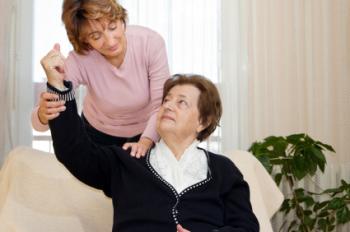
Parkinson's disease usually affects people over the age of 50.
These were the findings of a new study published in the journal Neurology. The research team at the University of Chicago, says:
"This is the first study to successfully treat swallowing dysfunction, and one of the first to treat difficulty with gait, using this unusual low-frequency 60 hertz stimulation."
The researchers explain that these conditions are usually hard to treat with drugs and the more common high-frequency 130 hertz deep brain stimulation.
The researchers believe their findings will make a significant difference to improving quality of care and potentially reducing Parkinson's disease severity and deaths.
Deep brain stimulation can alleviate Parkinson's symptoms that do not respond to drugs
Parkinson's disease is a motor system disorder that results from loss of brain cells that produce a chemical called dopamine. It usually affects people over the age of 50.
The main symptoms of Parkinson's disease include trembling in hands, arms, legs, jaw and face; stiffness of the limbs and trunk; slowness of movement; and impaired balance and coordination. The disease develops subtly and gradually and progresses at different speeds in different people. As it progresses, patients find it harder to walk, talk and complete simple tasks.
Other symptoms of Parkinson's disease include emotional changes, depression, difficulty in swallowing and chewing, problems with speaking, urinary problems, constipation, sleep disruption and skin problems.
There is currently no cure for Parkinson's disease, although a range of medications and treatments can have dramatic results in alleviating symptoms.
The condition is most often treated with levodopa combined with carbidopa. Carbidopa delays the conversion of levodopa into dopamine until it reaches the brain, replenishing the dwindling supply there. However, not all patients respond to this treatment.
Deep brain stimulation (DBS) is often used to alleviate symptoms of Parkinson's that cannot be controlled with drugs. In DBS, a "brain pacemaker" is implanted that sends carefully programmed electrical impulses to selected areas of the brain.
So far, routine use of DBS employs a high-frequency 130 hertz impulse. But this is not very effective at treating swallowing problems and freezing of gait - both symptoms that can lead to disability and early death of Parkinson's patients.
60 hertz DBS improves gait, swallowing and other symptoms unresponsive to 130 hertz
For their study, the researchers ran a small, double-blind trial with seven Parkinson's patients who had difficult-to-treat gait and swallowing symptoms and who were not responding to standard medication and DBS at the high 130 hertz frequency.
The patients were randomly assigned to receive either 60 hertz, 130 hertz or no stimulation (DBS switched off in the implant) in two separate sessions, 6 weeks apart.
Double-blind means neither the patients nor the clinicians administering the treatment knew which one they were receiving or giving.
The researchers took detailed measures of swallowing ability, freezing of gait and other symptoms. The patients also filled in questionnaires about their symptoms.
The results showed that compared to the higher 130 hertz frequency version, the lower frequency 60 hertz DBS reduced airway aspiration problems by 57% and swallowing difficulty by 80%. It also significantly reduced freezing of gait and axial symptoms. Axial symptoms include neck rigidity, problems with speech and postural instability, which are known to respond less well to levodopa.
Play the video below to find out more about the treatment.
Patients continued to receive the low-frequency DBS - still showing benefits 6 weeks later - note the authors.
The researchers say for patients with freezing gait who do not respond to the high-frequency treatment, low frequency, "60 hertz stimulation should be used as it not only improves gait, but also swallowing and other Parkinsonian symptoms."
It is more effective than 130 hertz in overall motor function, though it may not be good for those with medication refractory tremors.
At the time of reporting the study, six of the seven patients were still on the 60 hertz DBS treatment, and continuing to benefit from it, making it a year since treatment began.
The research team plans to follow up and continue to study these patients. They also want to discover the underlying circuitry in the brain that helps the treatment work.
References:
1. Low-frequency stimulation of STN-DBS reduces aspiration and freezing of gait in patients with PD, Tao Xie, et al., Neurology, doi:10.1212/WNL.0000000000001184, published online 24 December 2014, abstract.
2. University of Chicago Medicine news release, accessed 28 January 2015.
No comments:
Post a Comment